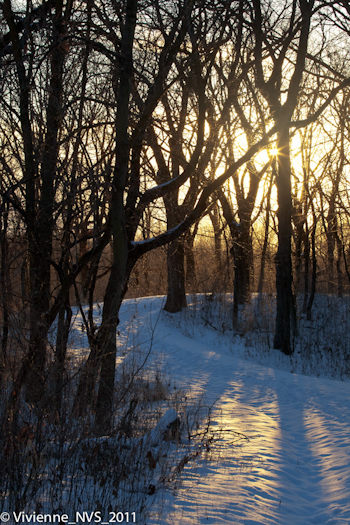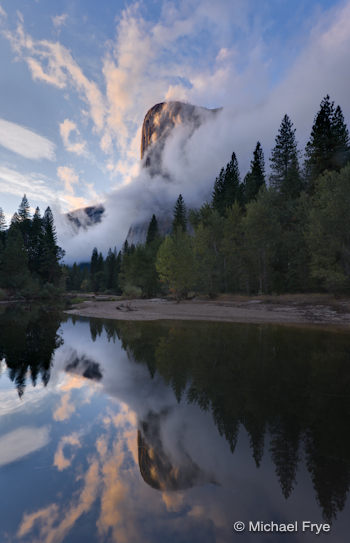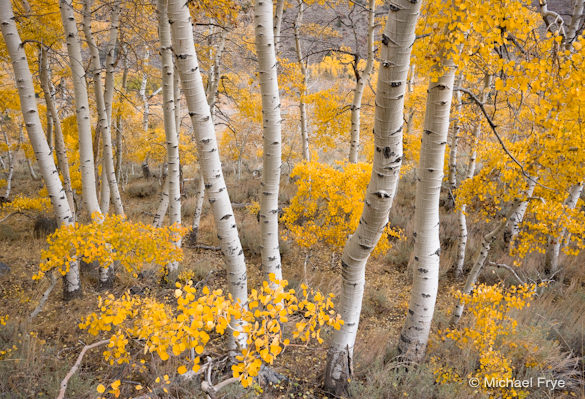In the Moment:
Michael Frye's Landscape Photography Blog
by Michael Frye | Apr 7, 2011 | Digital Photography Basics, Photography Tips
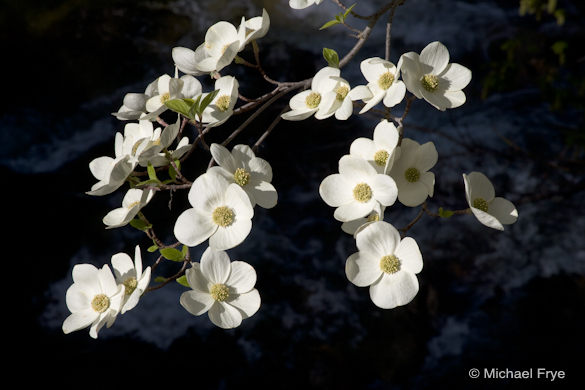
Most camera's light meters would read the dark areas in the background and overexpose these dogwood blossoms. To correct for this, you need to either override the meter with exposure compensation, or adjust the exposure manually.
In the first part of this series I explained one of the most fundamental aspects of digital photography: reading histograms. In this edition I’ll delve into the next step: how to adjust the exposure when the histogram doesn’t look right the first time.
(more…)
by Michael Frye | Apr 5, 2011 | Yosemite Photo Conditions
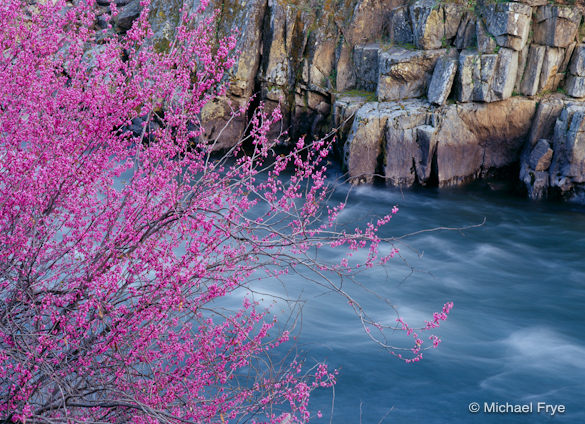 Redbud and Rocks along the Merced River. Soft light emphasized the colors.
Redbud and Rocks along the Merced River. Soft light emphasized the colors.
Flower Reports
They’re late this year, but the redbud are finally blooming in the Merced River Canyon, along Highway 140 west of Yosemite. I’d say they’re just short of peak; some have not yet bloomed, but none have leaves. Photographically, this is the most interesting time, as once they start to leaf out they’re not as photogenic.
The big snowstorm two weeks ago damaged some of the redbud near El Portal, but further west they’re in great shape. Look for them everywhere near the river along the main highway, as well as the Merced River Recreation Area at Briceburg.
So far few poppies have appeared near the Merced River. They might be late, or it just may turn out to be a poor year for them—time will tell. But the best poppy blooms I’ve seen here have always occurred in March.
(more…)
by Michael Frye | Mar 27, 2011 | Announcements, Photography Tips
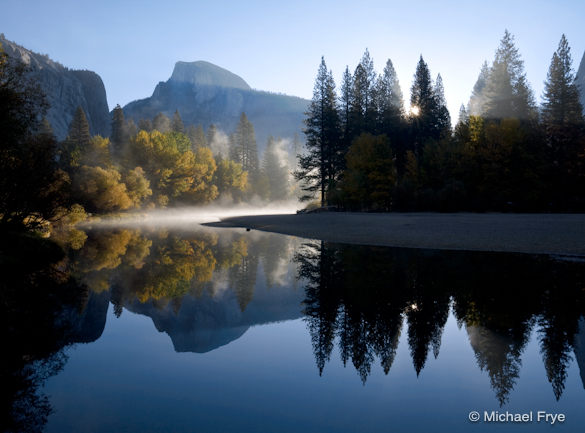 Autumn Sunrise, Half Dome and the Merced River
Autumn Sunrise, Half Dome and the Merced River
How do you give your photographs impact? How do you convey the grandeur of the landscape in a small, two-dimensional image? You have to find your focus. I’m not talking about turning the ring on your lens—I’m talking about focusing your composition on the essentials and finding a strong design.
My latest article in Outdoor Photographer magazine discusses exactly how to do that. Titled Find Your Focus, it shows you how to communicate your vision by simplifying, finding focal points, creating depth, and looking for patterns. The article is scheduled for the May issue, due out next month, but it’s already on the OutdoorPhotographer.com website—a sneak preview. I hope you enjoy the article!
by Michael Frye | Mar 23, 2011 | Yosemite Photo Conditions
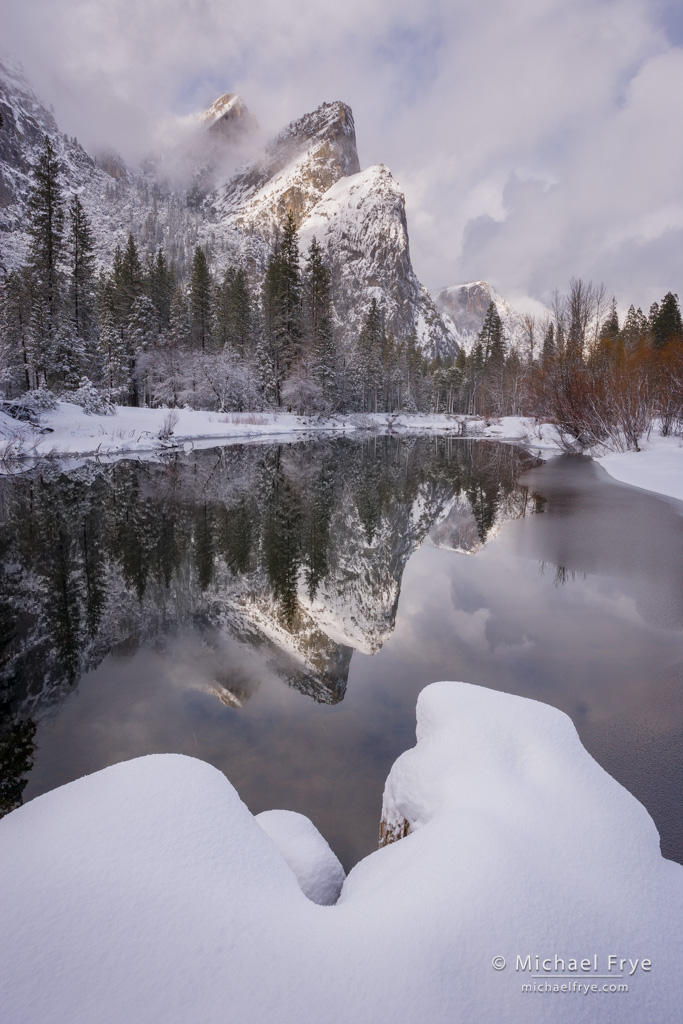
A snowy scene from 2008
A storm dumped three feet of snow in Yosemite Valley on Sunday and Monday, knocking down trees and power lines, and closing all roads into the park. Due to lack of electricity and water in Yosemite Valley, the park service evacuated all visitors and non-essential employees. The park won’t reopen until power is restored, which may not be until this weekend, or possibly later. The main electrical line into the park was cut by a rock slide that knocked over an electrical tower, and replacing the tower requires bringing in crews and equipment by helicopter.
More rain and snow are falling in the park today, another storm is expected to arrive tomorrow, and one more on Saturday. These additional weather systems may hamper efforts to clear roads and restore electricity.
Power is still out in many foothill communities outside the park, especially around Oakhurst. We lost electricity at our home in Mariposa for about eight hours on Monday, but this was a small problem compared to what some of our neighbors are dealing with. My mom, who lives outside of Oakhurst, is still without power, so she’d taken refuge with us.
Here’s a link to one story and video about this event, and here’s another, both from Fresno’s ABC30 web site. If any of you find links to other good information, please post them in the comments. If you’re planning to head to Yosemite, call 209-372-0200 for the latest road information.
(more…)
by Michael Frye | Mar 21, 2011 | Reviews

When I think about contemporary landscape photographers who’s work I admire and respect, Guy Tal is definitely on that list. He consistently produces beautiful work in a natural style that reflects his appreciation for the natural world.
I recently had the opportunity to review Guy’s eBook, Creative Landscape Photography. I’ve read a lot of books and articles about photography, and written a few myself, so it’s refreshing when I find something that presents a new idea, or a new way of looking at the process of photography. This book does that. Guy has the ability to get you to think in different ways about photography, and about your own approach to a subject. Rather than presenting recipes for successful photographs, or abstract philosophical ideas, he gives you concrete steps to help provoke your own thought process, and stimulate your creativity.
This includes a list of questions to ask yourself before photographing a subject, like, “What element(s) do I find most visually appealing about the scene?, or “What emotion(s) can I convey to my viewers using the elements in this scene?” All vital questions.. While highly-experienced photographers may consider such things instinctively and automatically, even they can use a reminder, and less experienced photographers will find that a conscious effort to answer these questions will pay big dividends.
Guy has always struck me as a thoughtful person, and that comes through in this volume. It’s clear that he’s has given a lot of thought to every aspect of landscape photography:
“A common enemy of good composition is the impulse when an attractive scene presents itself to immediately reach for the camera, snap a few quick exposures, and move on to continue the hunt. In reality, chances are your perspective will not be ideal at the precise moment you discover your subject.”
“Consider all the rules, take what works. Apply where appropriate, but do not be afraid to break every last one of them. Go with your instinct. Photograph for yourself and satisfy your own sensibilities and aesthetics. True artists do not pander to a pre-selected audience. Instead, they carve an audience of their own from those who will encounter and be moved by their work.”
The heart of the book is the first four sections, called The Creative Process, Concept, Visualization, and Composition. The remaining three parts—Capture, Processing, and Presentation—support the ideas presented in the beginning, explaining how to carry your original vision through to a finished photograph. The book also includes many of Guy’s beautiful photographs to inspire you, most from one of my favorite regions in the country, the canyons of southern Utah.
Anyone who’s serious about making better, more creative landscape photographs will learn a lot from this eBook. It’s available directly from Guy Tal’s web site for 9.95. He’s also announced a sequel,Creative Processing Techniques in Nature Photography, due out later this year.
by Michael Frye | Mar 17, 2011 | Critiques
“Late Afternoon, Moraine Hills State Park” by Vivienne Shen
Light and Mood
This week’s photograph was made by Vivienne Shen at Moraine Hills State Park, near Chicago, Illinois.
The light in this image really caught my eye, with the sun peeking through branches, the long tree shadows in the foreground, and the golden, late-afternoon colors. The light, bare trees, and snowy ground combine to create a strong mood—cold and wintry, but with a hint of warmth.
There’s nothing special about the weather here; you could probably capture similar light on any clear winter afternoon. This shows that you don’t need extraordinary conditions to convey a mood—you just need to visually emphasize the conditions you have. Here everything in the frame (snow, bare trees, low-hanging sun) communicates the idea of a cold, clear, winter day.
(more…)
by Michael Frye | Mar 16, 2011 | Announcements
Cloud formations, El Capitan
My next exhibit at The Ansel Adams Gallery, titled “Reflections on Yosemite,” opens on April 18th and runs through May 25th.
The show will feature images of Yosemite, a place I’ve photographed for over 25 years. Since my last exhibit at the Gallery in 2009 I’ve made a lot of new images that I’m excited about, so I’m looking forward to presenting some of this new work, as well as selecting a few of my classic Yosemite photographs to include in the mix.
Join us for the artist’s reception on Saturday, May 7th, from 3 to 5 p.m. at the Gallery (next to the Visitor Center in Yosemite Valley). Early May is a great time to photograph dogwoods and waterfalls in the park, so you could combine a weekend of photography with a visit to the reception. Hope to see some of you there!
by Michael Frye | Mar 9, 2011 | Yosemite Photo Conditions
Wildflowers in the Temblor Range, Spring 2010
It’s been a strange winter in California. November and December were exceptionally wet, January and early February were almost completely dry, then we finally got some rain again in late February and the beginning of March. Now the weather has turned warm and dry once more, bringing thoughts of spring, and wildflowers.
Most of the best wildflower areas in Southern California received above average rainfall, as you can see from this NOAA map. But that six-week dry spell at the beginning of the year may have thrown many of the plants off their rhythm, so it’s difficult to predict what kind of wildflower season it might be. It seems likely that somewhere, sometime, we’ll see some great blooms—but where, and when?
The best I can tell you at this point is to look and listen for the wildflower reports as they come in. While Carol Leigh has discontinued her California Wildflower Hotsheet, she still administers the CalPhoto group on Yahoo, which is always a good resource for wildflower reports. Kahlee Brighton has also started listing flower sightings at the Wildflower Conservancy.
DesertUSA is another valuable site, with wildflower reports for Arizona, Nevada, New Mexico, and Texas as well as California. Also check out the Theodore Payne Foundation’s Wildflower Hotline. Sandy Steinman has a comprehensive list of links to wildflower reports on his blog.
These links just scratch the surface of what’s available, so if you know of other good sources please feel free to post them in the comments. And of course I’ll keep you up to date on what’s happening around the Yosemite area on this blog. So far, not much!
by Michael Frye | Mar 3, 2011 | Digital Darkroom, Photography Tips
Lightroom has grown up. I’ve made 30×40 inch prints from this image using only Lightroom (except for the final print sharpening). Yet Photoshop can still do things that Lightroom can’t.
“Should I get Lightroom or Photoshop?” This is a question I get asked a lot, usually by people who own Photoshop Elements and are thinking of upgrading to either Lightroom or the full version of Photoshop.
Six years ago this was an easy decision, because Lightroom didn’t exist. If you wanted to upgrade from Elements, the full version of Photoshop was the only real choice. But then Apple launched Aperture, Adobe countered with Lightroom, Nikon and Canon upgraded their software, and a host of other companies added even more options.
For now I’m going to keep this simple and just talk about Lightroom and Photoshop—mainly because these are the two most popular choices, but also because they’re the two applications I’m most familiar with, and they’re natural choices for people wishing to graduate from Adobe’s other photo-editing program, Elements.
(more…)
by Michael Frye | Mar 3, 2011 | Yosemite Photo Conditions
El Capitan and the Merced River, 8:23 this morning
Rain fell on and off since Tuesday night, but skies finally cleared out this afternoon. This morning, before the rain left completely, I got to photograph a beautiful break between squalls, with swirling mist around El Capitan, and sun illuminating the cliff and clouds. It probably looked great from Tunnel View also, and I’d love to see photos from there, or other spots in the valley. If you were in the park this morning, please post links to your photos in the comments!
Another storm is due Sunday and Monday. This next one might be a little colder, so we could see snow at the tail end of it. And forecasters are expecting more wet weather later in the week. This is the best time of year for evening photographs from Tunnel View, when late-day sunlight strikes both El Capitan on the left and Cathedral Rocks on the right. If we’re lucky one of these storms might clear in the afternoon and add some clouds and mist to that balanced light.






